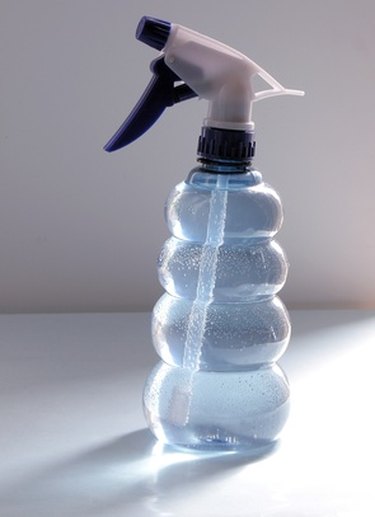Things You'll Need
10cc syringe of Panellus stipticus spawn
Sterilized mushroom grow bag with injection site and rye grain pocket
18-gallon plastic container with lid
Quart-size bottle sprayer
1/4 cup bleach
Paper towels
Thermometer
1-gallon distilled water
Second quart-size bottle sprayer
1/4-cup measure
Clothes pin
Imagine trudging through a dark forest at night and coming upon glowing blobs near the bases of trees: A few types of mushrooms, such as Lions Mane, Ghost Fungus and Jack-O-Lantern, have bioluminescent properties, causing them to have a green glow. Mushroom-growing hobbyists produce the bioluminescent beauties in their own kitchens and bathrooms. The variety called Panellus stipticus is one of the brightest that can be grown in sterilized blocks of wood shavings using pre-cultured spawn. Both can be purchased on the Internet. This variety is not edible, not psychoactive, and is only grown as a novelty for its bioluminescent properties.
Inoculate Growing Medium
Step 1
Purchase spawn and the prepared mushroom grow bag with the rye grain pocket from a mushroom supplier (see Resources). Order the 10cc syringe of Panellus stipticus spawn and the sterilized mushroom grow bag with injection site and rye grain pocket. The additional grain makes it easier for the spawn to colonize the bag of sterilized growing medium.
Video of the Day
Step 2
Purchase an 18-gallon plastic container with lid prior to the arrival of the spawn and growing medium.
Step 3

Add 1/4 cup bleach to the quart-size bottle sprayer, on the day the spawn and growing medium arrive in the mail. Spray the interior of the 18-gallon plastic container and the inside of the lid with the bleach mixture. Wipe dry with the paper towel. Close the lid to keep out spores that may be in the air.
Step 4
Spray the kitchen counter with the bleach solution and wipe dry with a paper towel. Place the bag of growing medium and the syringe on top of the counter work space and have the 18-gallon container nearby.
Step 5
Attach the needle to the syringe by twisting it into place, remove the needle guard and place the needle tip into the marked injection site on the bag. Depress the plunger to empty the contents of the syringe into the rye grain pocket. Place the inoculated bag into the 18-gallon plastic-container grow chamber. Snap the lid into place.
Step 6
Check on development of mycelium daily. Keep it in an area where temperatures range from 65 to 80 degrees Fahrenheit. Fan the bag using the lid of the container because this type of mushroom loves fresh air.
Distribute Colonized Rye Seed
Step 1
Cut open the top of the bag when the mycelium has colonized the grain pocket with white fluffy growth (this should take about two weeks). Add 1/4 cup of distilled water. Squeeze the bag to distribute the fluffy white mycelium throughout the rest of the growing medium. Close the bag by folding down the top of the bag and securing it with a clothes pin. Place it back into the growing chamber for about a week.
Step 2
Open and observe the development of the mycelium daily. When the entire bag becomes colonized with white mycelium, move the container to the outdoors in an area where temperatures range from 60 to 75 degrees Fahrenheit. Cut off the top of the bag to expose the colonized substrate to fresh air. Place the container without the lid in an area protected from rain and sunlight where the mushroom colony can receive lots of fresh air.
Step 3
Observe the colony daily for fruiting bodies (which look like little mushroom caps). Fill a new quart-size sprayer bottle with distilled water, and moisten the surface daily to keep it from drying out. Transport the fully developed bag of fruiting bodies, which look like traditional mushroom caps, into a dark area for observation of the green glowing bioluminescence.
Video of the Day
- Jack-O'-Lantern Mushrooms, Jennifer E. Frick
- Museum Victoria: Forest Secrets: Ghost Fungus.
- Lycaeum: Bioluminescent Mushrooms, no author given
- Some Mushroom Growing Basics for Beginners, Randall R. Wayne, Ph.D
- Everything Mushrooms: Supplier
- Bay Area Mycological Society: The "Jack O Lantern Mushroom", Debbie Viess